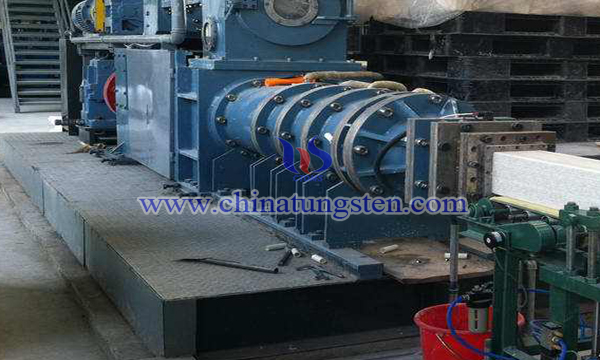SCR Catalyst Recovery Tungsten and Vanadium Process
- Details
- Category: Tungsten Information
- Published on Wednesday, 28 November 2018 23:06
SCR catalyst is a kind of denitrification catalyst. In the denitrification reaction, the role of SCR catalyst is to promote the selective chemical reaction between reductant and nitrogen oxides in flue gas at a certain temperature. Tungsten vanadium titanium catalyst is the most popular catalyst in our country. Its life span is only 3-5 years. Once discarded, if improperly treated, the active ingredient V2O5, which is a highly toxic substance, will cause secondary pollution to the environment and endanger people's health and life safety.

At present, there are two main treatment methods for scrap SCR catalysts: one is regeneration of scrap catalysts through certain treatment; the other is harmless treatment of scrap SCR catalysts by chemical methods, and recovery of heavy metals such as tungsten and vanadium.
Some researchers have designed a process for recovering tungsten and vanadium from scrap SCR catalyst. The specific steps and conditions of the process are as follows:
1)Downstream multi-stage alkali leaching:
(a)100 scrap SCR catalysts with average particle size of 100-200 mesh were added into the alkali leaching solution prepared according to the mass ratio of water: strong alkali: dispersant = 100-600:5-100:0-20, stirred at 80-200 ℃ for 0.5-4 hours, cooled to 20-90 ℃ and filtered to obtain tungsten-vanadium alkali leaching solution and alkali leaching residue, respectively.
B.Adding medium-strong alkali to tungsten-vanadium alkali leaching solution and stirring reaction at 20-80 ℃ for 0.5-5 hours, the leaching solution and vanadium slag were filtered respectively. The initial mass ratio of medium-strong alkali to scrap SCR catalyst was 1-20:100.
C.100 scrap SCR catalysts with average particle size of 100-200 mesh were immersed in alkali leaching solution for vanadium removal. According to the mass ratio, scrap SCR catalysts were added with strong alkali = 100:0-60, then reacted at 80-200 ℃ for 0.5-4 hours, cooled to 20-90 ℃ and filtered to obtain tungsten-vanadium alkali leaching solution and alkali leaching residue, respectively.
D.Adding medium-strong alkali to tungsten-vanadium alkali leaching solution and stirring reaction at 20-80 ℃ for 0.5-5 hours, the vanadium-removal alkali leaching solution and vanadium residue were obtained by filtration. The initial mass ratio of medium-strong alkali to scrap SCR catalyst was 1-20:100.
Repeat step C and step d until the leaching stage is 3-10, then concentrate the final leaching solution to the concentration of WO3 140-200 g/L. Cool the crystallization to obtain sodium tungstate crystal and concentrated alkali solution. Sodium tungstate crystal is sent to purify and remove impurities, and sodium tungstate product is obtained. The concentrated alkali solution is recycled in step A. Vanadium slag obtained by filtration and separation at all levels is sold as vanadium ore.
2)Countercurrent multistage alkali leaching:
The alkali leaching residues obtained at all levels are first leached with 0.5-7 mol/L strong alkali solution at 20-120 ~℃ for 0.5-4 hours. The leaching solution and the alkali leaching residue are filtered and then the alkali leaching residue obtained from the reciprocal second stage is put into the leaching solution and leached at 20-120 ~℃ for 0.5-4 hours in the opposite direction. The final leaching solution and the alkali leaching residue are filtered to the end. The final leaching solution is merged into the next circulating downstream leaching step a to be used as the downstream alkali leaching solution. The alkali leaching residue obtained by countercurrent leaching is used as the raw material for the production of titanium dioxide powder.
In the process of vanadium-tungsten separation, medium-strong alkali was selected as vanadium-tungsten separation reagent, so that tungsten and vanadium in tungsten-vanadium alkali leaching solution could be effectively separated without consuming strong alkali in the solution, and the cost increase caused by acid mediation in the existing process could be avoided. The process route is simple and mature, the conditions are easy to control, and the cost of process equipment and raw materials is low. Therefore, it provides a large-scale industrial production way for the recovery and utilization of heavy metals tungsten and vanadium from scrap SCR catalysts.
- Tungsten Manufacturer & Supplier, Chinatungsten Online: www.chinatungsten.com
- Tungsten News & Prices of China Tungsten Industry Association: www.ctia.com.cn
- Molybdenum News & Price: news.molybdenum.com.cn
- Tel.: 86 592 5129696; Fax: 86 592 5129797; Email: sales@chinatungsten.com



 sales@chinatungsten.com
sales@chinatungsten.com